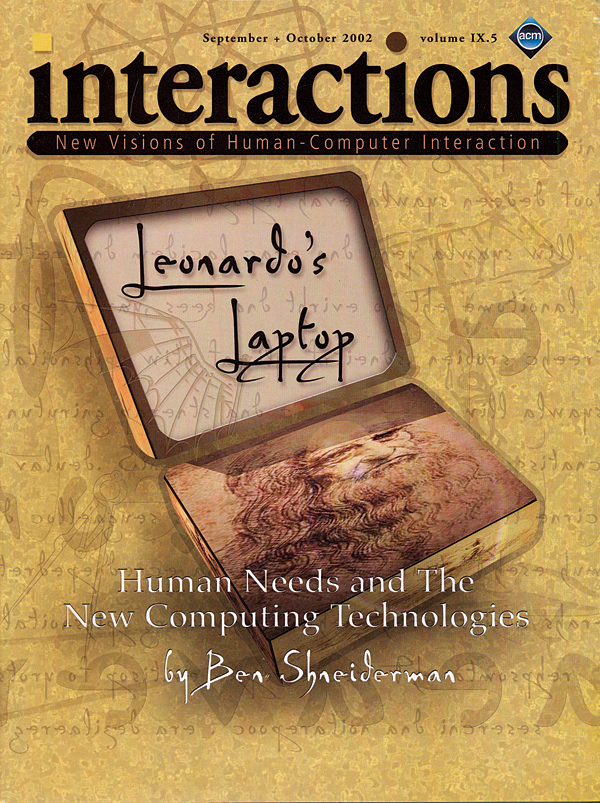Authors:
The following abstracts are from recent issues and the forthcoming issue of ACM's Transactions of Computer Human Interaction (ToCHI). They are included here to alert interactions' readers to what research is being done in the field of Computer Human Interaction. The complete papers, when published, can be found in ACM's Digital Library at www.acm.org/pubs/contents/journals/tochi/
"Generalization" in spreadsheets occurs when a formula referring to a particular cell is copied to other cells. Once the formula is copied, the system then needs to determine the appropriate references in the formulas of those new cells. We have developed a new generalization method that supports extending the spreadsheet paradigm beyond today's commercial spreadsheets, which are restricted to a single grid of cells.
The usual solution to generalization in commercial spreadsheet systems is to apply a strictly spatial approach based on physical relationships. In this approach, when a user copies or "fills" a formula into other cells, the system generalizes any cell references in the copied formula according to the distance of the new cells' number of rows and columns from the original cell.
However, the spreadsheet paradigm includes not only commercial spreadsheet systems, but also a number of research systems that extend the paradigm with features such as supporting multiple copies of the same sheet, graphical types, and high-quality visualizations of complex data. With these extensions, the spatial approach falls short, because the extensions require logical relationships—in addition to or instead of spatial relationships—to define the generalized meaning of the spreadsheet.
For example, suppose a population analyst wants to define
a visual representation of data using domain-specific
visualization rules that make use of the built-in
primitive Circle spreadsheet shown in
Figure 1. Figure 2 shows such
a visualization in Forms/3. The spreadsheet categorizes
population data into cities, towns, and villages, and
represents each with a differently sized black circle. If a
referenced cell is on another spreadsheet, the notation
displayed in the formula is to precede the cell name with the
spreadsheet name and a colon, such as
"282_primitiveCircle:
newCircle."
To create the spreadsheet shown in Figure
2, the population analyst sketches a circle, which
creates another instance of the system-provided
primitiveCircle spreadsheet (e.g.,
179_primitiveCircle), and then edits
the instance's cell fillForeColor to
Black and its cell
radius to be 1 +
(population:population[i@j] / 10000))
to refer generically to an element of the
Population grid.
The analyst's task is finished, but the system still needs
to generalize further. If it did not generalize, all the
cells in the graph grid would be the
same size, because they would all refer to
newCircle on the same copy
(such as 179_primitiveCircle). After
the system generalizes, each reference in graph's formula
will be to cell newCircle on an
appropriate copy of
primitiveCircle.
After generalization, overly specific instances in the
formula, such as 179_primitiveCircle,
are treated as samples. The fact that they are now just
samples is communicated to users by the tiny key icon next to
them. If the user places the mouse over or clicks the key
icon, a legend is displayed, as in Figure
2(b), to show what the sample stands for.
Figure 2(b) says that the sample reference in
the formula for the Graph[i@j] cells
is to newCircle on a copy of
primitiveCircle, the
fillForeColor cell of which is Black
and the radius cell of which is calculated using
population:population[i@j].
How did this come about? The generalization method consists of two steps: (1) incrementally tracking logical relationships and (2) lazily generalizing these relationships "just in time." Step 1 consists of incrementally building a graph of the relationships among the cells. This step is triggered whenever a user establishes or changes a relationship by editing a formula. Step 2 uses this graph to generalize. It is triggered whenever the system determines that generalization cannot be delayed any longer. Sometimes the relationships are fairly simple to figure out, as in Figure 2, but sometimes they involve complex paths through a number of related cells. In Step 2, the system completes its work in a bottom-up fashion. Starting with an overly concrete cell reference, the system deduces a generalized description from the graph of relationships it built during Step 1 and substitutes, via algebraic back-substitution, the generalized description into all relevant formulas that use the concrete reference. Generalization is complete when all the concrete instances involved in the computation being generalized have finally been eliminated through these substitutions.
Acknowledgment
This research was supported in part by the National Science Foundation under awards CCR-9806821 and ITR-0082265 and by National Aeronautics and Space Administration grant NGT540022.
Authors
Margaret Burnett
Department of Computer Science
Oregon State University
Corvallis, OR 97331
[email protected]
Sherry Yang
Computer Systems Engineering Technology
Oregon Institute of Technology
3201 Campus Dr.
Klamath Falls, OR 97601
[email protected]
Jay Summet
College of Computing
Georgia Institute of Technology
Atlanta, GA 30332-0280
[email protected]
 Figure 1. A portion of a Forms/3
spreadsheet that defines a circle. The attributes of the
circle in cell
Figure 1. A portion of a Forms/3
spreadsheet that defines a circle. The attributes of the
circle in cell newCircle are
specified by the other cells, some of which look like buttons
and menus.
 Figure 2. (a) The population
spreadsheet in Forms/3. Generalization has occurred, as is
clear from the different circles in
Figure 2. (a) The population
spreadsheet in Forms/3. Generalization has occurred, as is
clear from the different circles in
Graph's different cells, even though
they all share the same formula. (b) The legend showing what
179_primitiveCircle has been
generalized to mean.
©2002 ACM 1072-5220/02/0900 $5.00
Permission to make digital or hard copies of all or part of this work for personal or classroom use is granted without fee provided that copies are not made or distributed for profit or commercial advantage and that copies bear this notice and the full citation on the first page. To copy otherwise, to republish, to post on servers or to redistribute to lists, requires prior specific permission and/or a fee.







Post Comment
No Comments Found